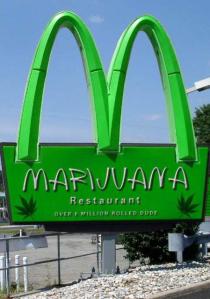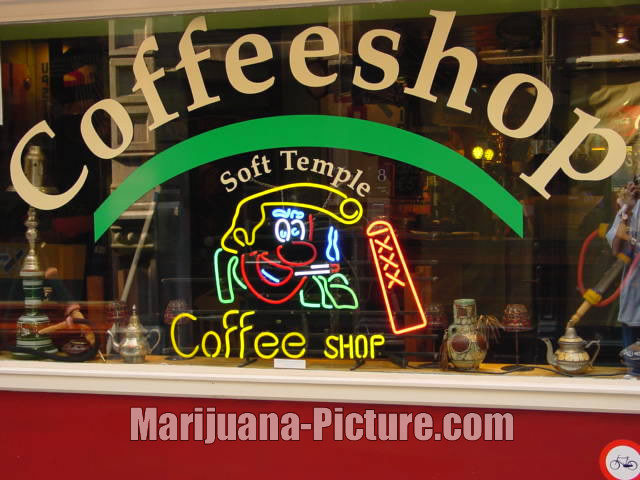Hhaha






 The Netherlands Compared With The United States
The Netherlands Compared With The United StatesThe Netherlands follows a policy of separating the market for illicit drugs. Cannabis is primarily purchased through coffee shops. Coffee shops offer no or few possibilities for purchasing illicit drugs other than cannabis. Thus The Netherlands achieve a separation of the soft drug market from the hard drugs market - and separation of the 'acceptable risk' drug user from the 'unacceptable risk' drug user.
Source: Abraham, Manja D., University of Amsterdam, Centre for Drug Research, Places of Drug Purchase in The Netherlands (Amsterdam: University of Amsterdam, September 1999), pp. 1-5.
http://proxy.baremetal.com/csdp.org/research/places.pdf"Prevailing laws
"The most important provisions regarding drugs are laid down in the Opium Act. Since 1976, the Act has made a distinction between hard drugs (drugs with an unacceptable risk to public health, including heroin, cocaine, LSD and ecstasy) and drugs that entail a less significant risk (hash and marijuana). Fresh magic mushrooms were added, along with dry magic mushrooms, to the provisions of the Opium Act, List II, on 1 December 2008. As a result, the sale of fresh magic mushrooms is now prohibited.
"Possessing, dealing in, selling and producing drugs are criminal offences. Use is not.
" Offences are punished more severely if hard drugs (drugs with unacceptable risks) are a factor.
" The possession of drugs for the purpose of dealing is also more severely penalized that possession for ones own personal use (see level of punishment).
" The police and the judiciary give priority to tackling the large-scale drug trade and the production of drugs, which means that small-scale dealers and users are not systematically pursued (see the principle of expediency).
" The sale of small quantities of soft drugs in coffeeshops is an offence, but in practice prosecutions are only generally made if the coffeeshop in question does not adhere to what are known as the AHOJ-G criteria (see AHOJ-G criteria).
" The aim of allowing controlled sales outlets for cannabis is to separate the markets so that cannabis users do not come into contact with hard drugs and a criminal subculture when making their purchase."
Source: D. van der Gouwe, E. Ehrlich, M.W. van Laar, "Drug policies in the Netherlands," Trimbos Institute, (March, 2009), p. 5.
http://www.minvws.nl/includes/dl/openbestand.asp?File=/images/fo-drug-po...
"Dutch drug policy gives priority to a public health approach. In some cases, this resulted in a certain degree of tolerance and non-prosecution, instead of strict law enforcement. We give some examples:
" The Drugs Information and Monitoring System (DIMS): this service co-ordinates pill testing at special test locations (not at parties) to determine health risks, to get insight in available new drugs and in trends in substance use (see also 10). Participants of DIMS will not be prosecuted (Staatscourant 2000, nr.250).
" Safe Injection Rooms/User Rooms: in some municipalities hard drug users can use drugs in protected rooms, specially created for them by the local authority (see also 10). Drug dealing in or around user rooms is forbidden (Staatscourant 2000, nr.250).
" Coffee-shop policy: Coffee shops are alcohol free outlets resembling bars, pubs or cafιs, where adults - eighteen years or older - may individually purchase cannabis up to five grams (Staatscourant 2000, nr.250). Yet, suppressing large-scale commercial production of cannabis is a high law enforcement priority."
Source: Trimbos Institute, "Report to the EMCDDA by the Reitox National Focal Point, The Netherlands Drug Situation 2002" (Lisboa, Portugal: European Monitoring Centre for Drugs and Drug Addiction, Nov. 2002), p. 12.
http://www.emcdda.europa.eu/attachements.cfm/att_34828_EN_NR2002Netherla...
"Coffeeshops are tolerated with a view to protecting public health. The purpose here is to create a distinction between the markets for soft and hard drugs so that people who wish to use cannabis do not gradually slip into contact with hard drugs. The regulations governing coffeeshops are very rigorous. No alcohol or hard drugs may be sold or consumed there, and they are not allowed to advertise. Cannabis may only be sold to people who are aged 18 or over."
"The coffeeshops must adhere to what are known as the AHOJ-G criteria: no advertising, no sale of hard drugs, no public nuisance, no entry to young people under 18 years of age, and no sale of large quantities (more than five grams per transaction). The maximum level of stock for selling is set at 500 grams, although local authorities are entitled to impose lower limits."
Source: D. van der Gouwe, E. Ehrlich, M.W. van Laar, "Drug policies in the Netherlands," Trimbos Institute, (March, 2009), p. 9.
http://www.minvws.nl/includes/dl/openbestand.asp?File=/images/fo-drug-po...
"The National Youth Health Surveys (in 1988, 1992, 1996, 1999) among pupils (12-18 years) showed that the increase in cannabis use since 1988 stabilised between 1996 and 1999 (De Zwart et al. 2000). According to the Health Behaviour in School-aged Children study, this trend continued in 2001 (Ter Bogt et al. 2003). Use of other drugs showed a similar trend or slightly drecreased (LTP of ecstasy and amphetamine)."
Source: Trimbos Institute, "Report to the EMCDDA by the Reitox National Focal Point, The Netherlands Drug Situation 2003" (Lisboa, Portugal: European Monitoring Centre for Drugs and Drug Addiction, Dec. 2003), p. 19.
http://www.emcdda.europa.eu/attachements.cfm/att_34350_EN_NR2003Netherla...
"The number of problem opiate/crack users seems to have remained relatively stable in the past ten years (3.1 per 1000 people aged 15-64 years). In the past decade, local field studies among traditional groups of problem opiate users have shown a strong in-crease in the co-use of crack cocaine, a reduction in injecting drug use, and an increase in psychiatric and somatic comorbidity."
Source: Trimbos Institute, "Drug Situation 2006 The Netherlands by the Reitox National Focal Point: Report to the EMCDDA" (Utrecht, Netherlands: Trimbos-Instuut, 2007), p. 9.
http://www.a-klinikka.fi/ajankohtaista/paihdetiedotusseminaari07/Nationa...
(2005 - The Netherlands) "In 2005, the prevalence of last year cannabis use was about 2.5 times higher among men than women (7.8% as against 3.1%). This male-female ratio was marginally smaller in previous years (almost 2). Apparently the gender gap is not narrowing."
Source: Trimbos Institute, "Drug Situation 2006 The Netherlands by the Reitox National Focal Point: Report to the EMCDDA" (Utrecht, Netherlands: Trimbos-Instuut, 2007), p. 26.
http://www.a-klinikka.fi/ajankohtaista/paihdetiedotusseminaari07/Nationa...
Comparing Important Drug and Violence Indicators
Social Indicator Comparison Year USA Netherlands
Lifetime prevalence of marijuana use (ages 12+) 2001 36.9% 1 17.0% 2
Past month prevalence of marijuana use (ages 12+) 2001 5.4% 1 3.0% 2
Lifetime prevalence of heroin use (ages 12+) 2001 1.4% 1 0.4% 2
Incarceration Rate per 100,000 population 2002 701 3 100 4
Per capita spending on criminal justice system (in Euros) 1998 379 5 223 5
Homicide rate per 100,000 population Average 1999-2001 5.56 6 1.51 6
Source: 1: US Department of Health and Human Services (HHS), Substance Abuse and Mental Health Services Administration, National Household Survey on Drug Abuse: Volume I. Summary of National Findings (Washington, DC: HHS, August 2002), p. 109, Table H.1.
2: Trimbos Institute, "Report to the EMCDDA by the Reitox National Focal Point, The Netherlands Drug Situation 2002" (Lisboa, Portugal: European Monitoring Centre for Drugs and Drug Addiction, Nov. 2002), p. 28, Table 2.1.
3: Walmsley, Roy, "World Prison Population List (fifth edition) (London, England: Research, Development and Statistics Directorate of the Home Office), Dec. 2003, p. 3, Table 2.
4: Walmsley, Roy, "World Prison Population List (fifth edition) (London, England: Research, Development and Statistics Directorate of the Home Office), Dec. 2003, p. 5, Table 4.
5: van Dijk, Frans & Jaap de Waard, "Legal infrastructure of the Netherlands in international perspective: Crime control" (Netherlands: Ministry of Justice, June 2000), p. 9, Table S.13.
6: Barclay, Gordon, Cynthia Tavares, Sally Kenny, Arsalaan Siddique & Emma Wilby, "International comparisons of criminal justice statistics 2001," Issue 12/03 (London, England: Home Office Research, Development & Statistics Directorate, October 2003), p. 10, Table 1.1.
"The figures for cannabis use among the general population reveal the same pictures. The Netherlands does not differ greatly from other European countries. In contrast, a comparison with the US shows a striking difference in this area: 32.9% of Americans aged 12 and above have experience with cannabis and 5.1% have used in the past month. These figures are twice as high as those in the Netherlands."
Source: Netherlands Ministry of Health, Welfare and Sport, Drug Policy in the Netherlands: Progress Report September 1997-September 1999, (The Hague: Ministry of Health, Welfare and Sport, November 1999), pp. 7-8.
"The prevalence figures for cocaine use in the Netherlands do not differ greatly from those for other European countries. However, the discrepancy with the United States is very large. The percentage of the general population who have used cocaine at some point is 10.5% in the US, five times higher than in the Netherlands. The percentage who have used cocaine in the past month is 0.7% in the US, compared with 0.2% in the Netherlands.*"
Source: Netherlands Ministry of Health, Welfare and Sport, Drug Policy in the Netherlands: Progress Report September 1997-September 1999, (The Hague: Ministry of Health, Welfare and Sport, November 1999), p. 6. The report notes "*The figures quoted in this paragraph for drug use in the US are taken from the National Household Survey 1997, SAMHSA, Office of Applied Studies, Washington, DC".
http://www.drugwarfacts.org/cms/node/67